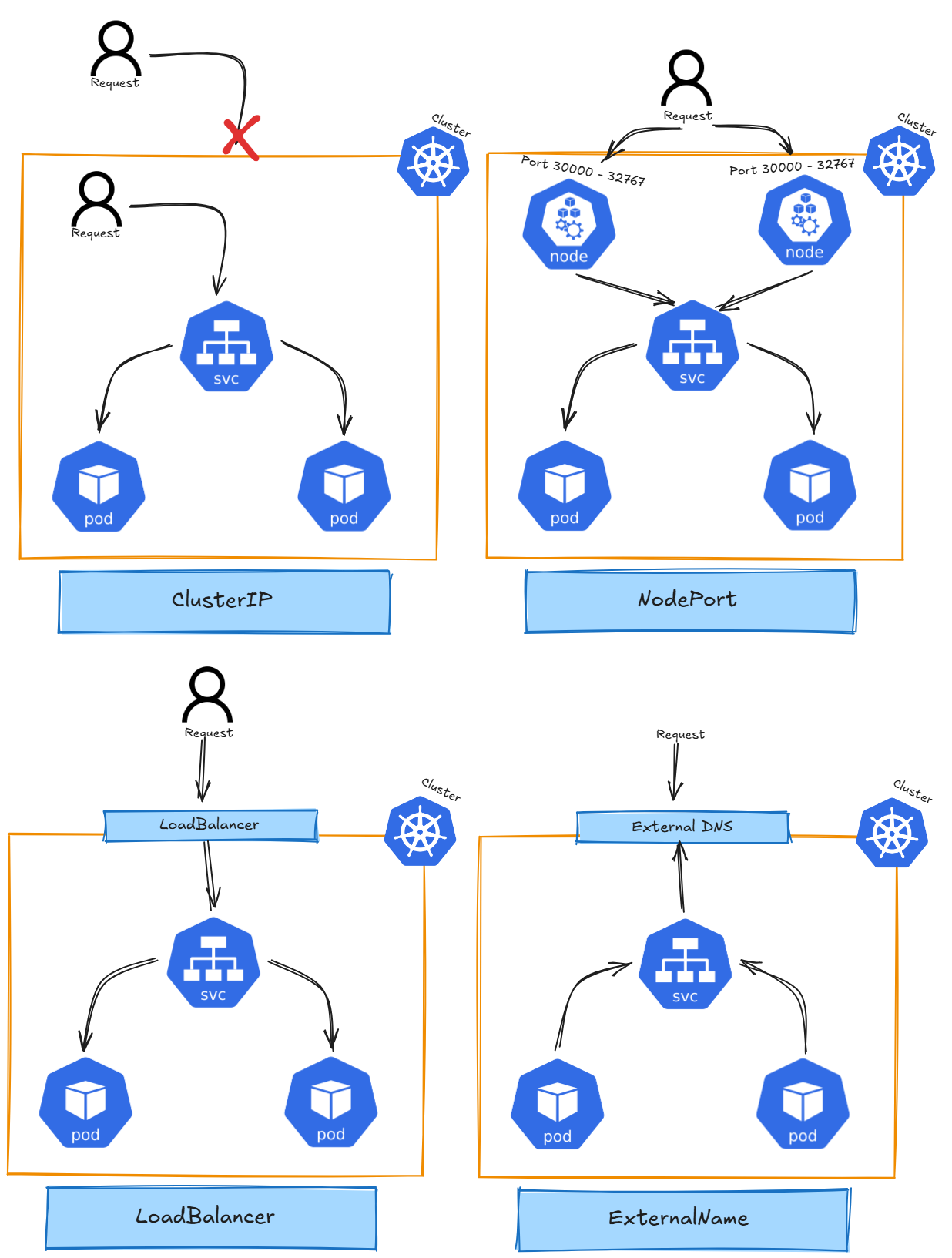Deployment / ReplicaSet

Useful Links
- Kubernetes Official Documentation
-
Using kubectl to Create a Deployment
https://thenewstack.io/kubernetes-deployments-work/
Architecture


Detailed Description
InKubernetes Kubernetes,Deployments aare Service is a waydesigned to exposemanage anstateless services in your cluster and are designed to define the desired state of your application.
The Desired State describes how your application runningshould insidelook ain setKubernetes. ofYou tell Kubernetes:
- How many Pods
asshouldabenetworkrunning? - Which
ItcontainerprovidesimageashouldstablebeIPused? - What
andconfigurationsDNS(e.g.,name,environmentallowingvariables,accessports)eithershouldfrombeoutsideapplied?
A ServiceDeployment serves as an abstraction layer, connecting clients to the appropriate Pods, ensuringensures that the actual Podsstate behindin the Servicecluster canmatches changethe withoutdesired disruptingstate. access.For example, if a Pod crashes, Kubernetes automatically creates a new one to maintain the desired state.
ThereKey are different types of Services in Kubernetes, including:Features
-
ClusterIP:Rollbacks:TheRevertdefaulttoserviceatypepreviousthatversionassignsduring aninternalupdateIP,issuereachableusingonlykubectlwithinrolloutthe cluster. It allows communication between Pods inside the cluster.Kube-Proxyload balances traffic across pods behind a ClusterIP Service.undo. -
NodePort:Rolling Updates:ExposesSmooththetransitionsservicebetweenonversions,asupportedstaticby:port-
allmaxSurge:nodesTemporary increase inthePodscluster,duringallowingupdatesexternal(e.g.,traffic25%). -
accessmaxUnavailable:theAllowableservice.percentage of Pods down during updates (e.g., 25%).
acrossto -
-
LoadBalancer:Scaling:InAdjustcloudreplicaenvironments,countsthiswithservicekubectltype provisions an external load balancer to distribute traffic to multiple Pods.scale. -
ExternalName:Monitoring Updates:MapsUseakubectlservicerollout status toantrackexternalrolloutDNS name, allowing Kubernetes services to refer to external resources.progress. -
Headless
ADeployments typemanage ofReplicaSets, ClusterIPprimarily servicedue withto historical reasons. There is no assignedpractical IP. It allows direct accessneed to Podsmanually withoutcreate ReplicaSets anymore, as Deployments provide a proxy.more
Endpoints are associated with a Serviceuser-friendly and representfeature-rich the IP addresses of the Pods that match the Service's selector. When a Service is created, Kubernetes automatically creates Endpointsabstraction for it,managing enablingapplication trafficlifecycle, forwardingincluding toreplication, theupdates, correctand Pods.rollbacks.
Command Reference Guide
Cluster IP
# Create nginx deployment with three replicas
kubectl create deployment nginx --image=nginxdemos/hello --port=80 --replicas=3
# Expose application as ClusterIP with port 8080 (ClusterIP is the default if not defined)
kubectl expose deployment nginx --type=ClusterIP --port=8080 --target-port=80
# --port=8080: The port exposed by the service (used internally to access the deployment)
# --target-port=80: The port on the pods where the application is running
# Get services
kubectl get service nginx -o wide
# Get full resource description using describe
kubectl describe service/nginx
# Get created endpoints
kubectl get endpoints
# curl by default service DNS entry
# Each curl request gets a different hostname due to Kubernetes' Kube-Proxy load balancing
curl nginx.default.svc.cluster.local
# Delete service
kubectl delete service/nginx
NodePort:
# Create nginx deployment with three replicas
kubectl create deployment nginx --image=nginxdemos/hello --port=80 --replicas=3
# Expose application as NodePort
kubectl expose deployment/nginx --type=NodePort
# Get services
kubectl get service nginx -o wide
# first Port = application;second Port = NodePort
# Get full resource description using describe
kubectl describe service/nginx
# Delete service
kubectl delete service/nginx
LoadBalancer
# Create nginx deployment with three replicas
kubectl create deployment nginx --image=nginxdemos/hello --port=80 --replicas=3
# Expose application as LoadBalancer
kubectl expose deployment/nginx --type=LoadBalancer --port 8080 --target-port 80
# Get services
kubectl get service nginx -o wide
# first Port = application;second Port = NodePort
# Get full resource description using describe
kubectl describe service/nginx
# Delete service
kubectl delete service/nginx
ExternalName
# Query running pods
kubectl get pods
# Query detailed informatoin about pods
kubectl get pods -o wide
# Create single pod
kubectl run nginx --image=nginx
# Run image / pass environment and command
kubectl run --image=ubuntu ubuntu --env="KEY=VALUE" -- sleep infinity
# Get yaml configuration for the resource
kubectl run nginx --image=nginx --dry-run=client -o yaml | tee nginx.yaml
# Get specific information of any yaml section
kubectl explain pod.spec.restartPolicy
# Create pod resource from yaml configuration file
kubectl create -f nginx.yaml
# Apply pod resource from yaml configuration
kubectl apply -f nginx.yaml
# Delete pod resource wihtout waiting for graceful shutdown of application (--now)
kubectl delete pod/nginx pod/ubuntu --now
# Get full resource description using descripe
kubectl describe pod/nginx
# Get logs for a specific container in the pod
kubectl logs pod/nginx -c nginx
# If a pod fails use -p to get previouse logs for a specific container in the pod
kubectl logs pod/nginx -c nginx -p
# Combine pod creation
kubectl run nginx --image=nginx --dry-run=client -o yaml | tee nginx.yaml
kubectl run ubuntu --image=ubuntu --dry-run=client -o yaml | tee ubuntu.yaml
{ cat nginx.yaml; echo "---"; cat ubuntu.yaml; } | tee multi_pods.yaml
kubectl apply -f multi_pods.yaml
Headless Service
# Query running pods
kubectl get pods
# Query detailed informatoin about pods
kubectl get pods -o wide
# Create single pod
kubectl run nginx --image=nginx
# Run image / pass environment and command
kubectl run --image=ubuntu ubuntu --env="KEY=VALUE" -- sleep infinity
# Get yaml configuration for the resource
kubectl run nginx --image=nginx --dry-run=client -o yaml | tee nginx.yaml
# Get specific information of any yaml section
kubectl explain pod.spec.restartPolicy
# Create pod resource from yaml configuration file
kubectl create -f nginx.yaml
# Apply pod resource from yaml configuration
kubectl apply -f nginx.yaml
# Delete pod resource wihtout waiting for graceful shutdown of application (--now)
kubectl delete pod/nginx pod/ubuntu --now
# Get full resource description using descripe
kubectl describe pod/nginx
# Get logs for a specific container in the pod
kubectl logs pod/nginx -c nginx
# If a pod fails use -p to get previouse logs for a specific container in the pod
kubectl logs pod/nginx -c nginx -p
# Combine pod creation
kubectl run nginx --image=nginx --dry-run=client -o yaml | tee nginx.yaml
kubectl run ubuntu --image=ubuntu --dry-run=client -o yaml | tee ubuntu.yaml
{ cat nginx.yaml; echo "---"; cat ubuntu.yaml; } | tee multi_pods.yaml
kubectl apply -f multi_pods.yaml
Hints
When accessing an external IP (e.g., Node1's external IP), the hostname and IP displayed on the website may not change. To test Kubernetes' load-balancing behavior, cordon Node1 and delete the pod running on it. When you call Node1's IP again, kube-proxy will reroute the traffic to a healthy pod on another node.
Open questions
Why is the service DNS not reachable after creating service?? curl nginx.default.svc.cluster.local
My personal summary

